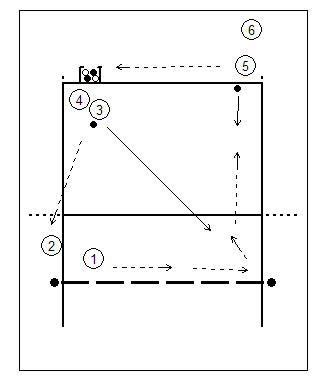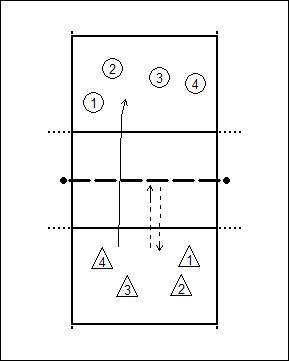Volleyball drills
Block defense with dive
- 1 first blocks middle and then left forward - turn around after block and defend attack by 3 - then defends (in dive) short ball by 5 - 2 is the next Rotate: - 1 to short ball - 3 to blocking - 5 to attack
- The attack comes from the right
- Block the middle and the diagonal, the outside attacker comes to the middle, the upper comes forward
- The trainer hits the ball, we go to our positions, and defend the trainer's ball.
- We keep rotating a spot.
- The remaining players defend for themselves and put the ball in the cart.
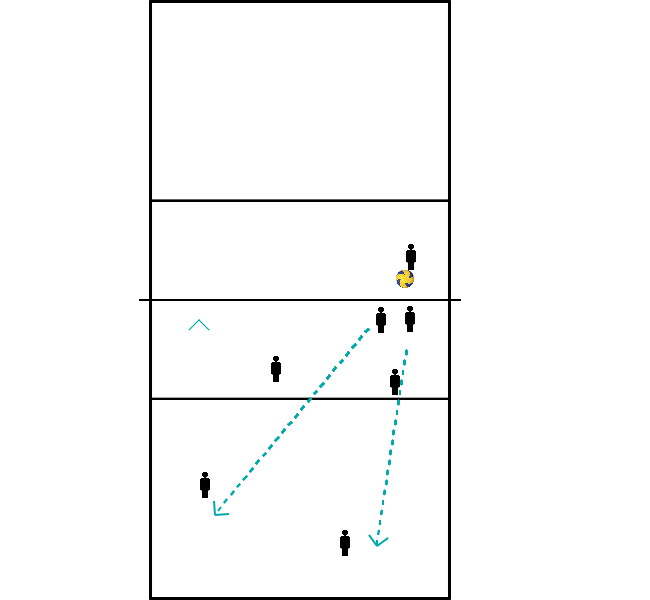
Explanation of the exercise:
- The players make pairs.
- Each pair has 1 ball.
- 1 player of the pair plays the ball overarm over the net.
- The other one catches. Alternatingly.
XL Challenge:
- Add a second ball.
- As soon as a player has played the ball overarm over the net, the other play throws the ball underhand over the net.
- You can make it even more difficult by playing both the balls overarm.
Left and right to 1 side of the net a line of attackers, playmaker on fixed position (right forward), passer left back. Three blockers on the other side of the net (right forward, middle, and left forward).
Ball is thrown from the other side to passer, passes to SV, sets up alternately to the attackers; mhidden blocker can only leave when set up has been played.
Points of attention:
- position of the hands (turned to position 6); place arms over the net (lock ball)
- jump after the attacker jumps
- middle player properly connects; outside blocker puts up block from outside to inside (never the other way around)
- bring the ball into the game; S sets up to left forward
- 1 diagonal attack
- all rotate one spot when ball is over the net
- defend diagonal attack on set-upper
- set up to left forward, attack diagonally; etc.
POINTS OF ATTENTION:
- when rotating, quickly to starting position
- all provide attack defense
- right forward block put straight
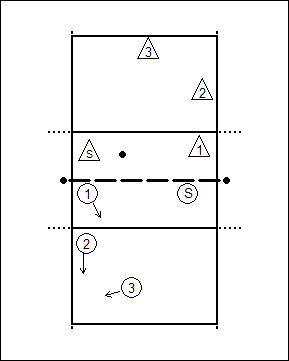

Moving as long as you can is for me the moment the attacker is about to hit the ball. At that moment the defender makes a split step and you make sure the focus of your body is being brought forward. So do not move backwards when the ball is hit, because your focus point is behind you and you will be too late to defend the ball before you. If the ball is defended, finish rally. |
- A serves to B.
- B passes the ball to the playmaker, who then plays a high ball in the back field.
- B defends this ball back to the playmaker, which gives a set up for A.
- A attacks to this set up.
After the attack, A takes the place of B, and B will be reserve. The playmaker remains.
The outside attackers use one playmaker and the left side of the field. The centre attackers and the diagonal attackers use the right side with a different playmaker.
Expansion:
- After the service, A takes a second ball.
- After the attack of B, A throws this ball into the field.
- B plays this ball to the playmaker, the playmaker gives a set up
- B attacks again.
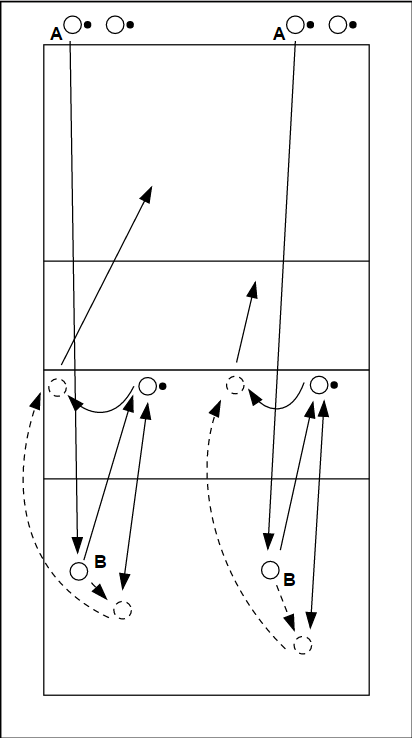
Pass and overarm exercise
- Player A and A1 have the ball.
- This player throws the ball to player B/B1
- Player B/B1 passes the ball back 'perfectly'
- Player A/A1 then plays the ball in the basket.
- Player A/A1 picks up the ball and joins the back of the line. You follow your ball
The tempo is automatic and can be increased. Make it harder by letting player B pass elsewhere, so player A has aim for the basket. Other option: Player A throws to a more difficult spot in the field.
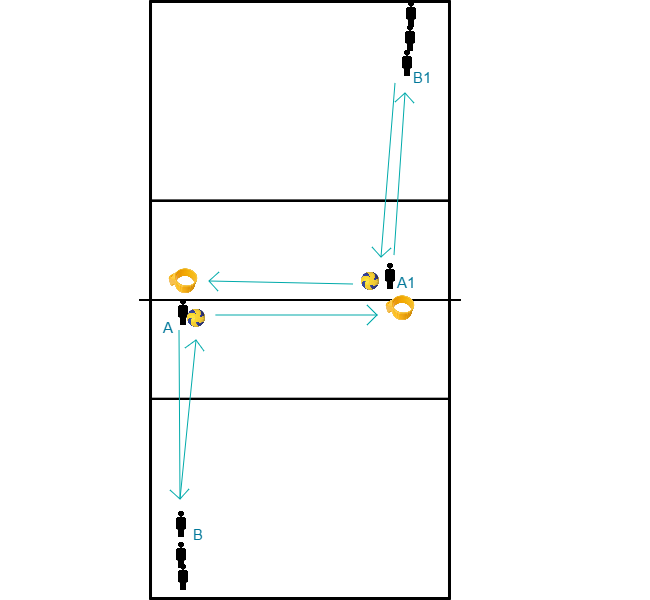
- defends box A (hard attack) and B (tactical ball) - rest attacks in sequence ( alternating hard and tactical)
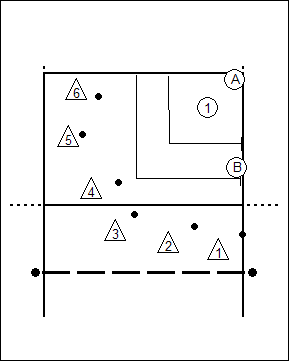
- 2 teams behind the three meter line - defend, set up, and three meter attack - when you have played the ball, you sprint to the net VARIATION: instead of sprint: block at the net duik naar achterlijn aanvalssprong

| If you put pressure on the opponent with your service and attack, the balls easily get over the net. It is a must to process these balls properly and (quickly) set up another attack. Precision is of the highest importance. The responsibilities have to be clear and taken by the players. It has to be clear for whom the easy ball is and who passes it. The place to which the ball is passed must also be clear. The speed of the rally pass is also of importance. Particularly when the playmaker is forward, you can pass the ball quicker to the net. Closer to the net, you pass the ball a bit higher, so everybody has time to prepare for the attack. The exercise: Coach throws ball in to the six. They build up an attack The six have to score from the rally pass. The four have to prevent this by blocking the ball and defend. When the 6 have 5 points, change. score keeping:
|
If volleyball players think they are starting the attack pass to soon, or the trainer thinks the attackers come in too soon, this is a good exercise.
The playmaker is positioned with a box of balls. He has to throw up the ball for himself 5 times or less. The attackers doe not know how often this happens, and can only leave when the set-up is done, not before.
The attackers will have to come in more aggressively, building up more speed and thus more height, if there is a good brake pass.
If this goes well, the trainer can decide to move the playmaker closer to the attackers, so the distance the set-upper has to cover is shortened. The attackers have to be even more alert.








